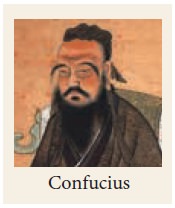Ancient Civilisations | History - The Chinese Civilisation | 9th Social Science : History : Ancient Civilisations
Chapter: 9th Social Science : History : Ancient Civilisations
The Chinese Civilisation
The Chinese Civilisation
China has two major rivers. One is known as Huang
He (Yellow River) and the other is called Yangtze River. The Yellow River is
known as the Sorrow of China, since it changed its course and caused frequent
floods.
Evidence for the prehistoric Peking man (700,000 BP and 200,000 BP)

and Yuanmou Man exists in China. Neolithic
communities lived in China between 4500 and 3750 BCE. The Henan province in the
Yellow and Yangtze river valley contain evidence for Neolithic villages. China
had many city states and gradually these states became part of an empire.
Polity and Emperors
Shi Huangdi (Qin Shi Huang, which means the first
emperor) founded the Qin (Chin) dynasty. The emperor had the title ‘son of
heaven’. He is considered to be the first emperor of China. The period between
221 and 206 BCE is known as the imperial era in China. He conquered other

principalities in 221 BCE and remained the emperor
till 212 BCE. He defeated the feudal lords and established a strong empire. He
is credited with unifying China. Shi Huangdi destroyed the walled
fortifications of different states and constructed the Great Wall of China to
protect the empire from the invading nomadic people. He also built roads to
integrate the empire.
The Han Empire (206–220 CE)
During this period, a written history of this
empire was made available in China. The greatest of the Han emperors, Wu Ti
(Han Wu the Great, 141 to 87 BCE), expanded the empire and built many public
amenities, including irrigation tanks. He sent Zhang Qian as emissary to the
West in 138 BCE and thereby paved the way for the opening of the Silk Road in
130 BCE to encourage trade activities.

Because of the Silk Road and the resultant trade
connections, China benefitted immensely during the rule of Emperor Zhang (75–88
CE) . Chinese silk was much sought after by the Romans during the time of the
Roman emperor Marcus Aurelius in 166 CE. Some of the Chinese silk might have
reached Rome through the ports of Tamilagam.
Philosophy and Literature
Chinese poets and philosophers such as Lao Tze,
Confucius, Mencius, Mo Ti (Mot Zu) and Tao Chien (365-427 CE) contributed to
the development of C hines e civilisation. Sun Tzu, a military strategist,
wrote the work called Art of War. The
Spring and Autumn Annals is the official chronicle of the state at the time. The
Yellow Emperor’s Canon of Medicine is
considered China’s earliest written book on medicine. It was codified during
the time of Han Dynasty.

Lao Tze (c. 604–521 BCE) was the master archive
keeper of Chou state. He was the founder of Taoism. He argued that desire is
the root cause of all evils.
Confucius (551–497 BCE) was famous among the
Chinese philosophers. He was a political reformer. His name means Kung the
master. He insisted on cultivation of one’s own personal life. He said, “If
personal life is cultivated, family life is regulated; and once family life is
regulated, national life is regulated.”
Mencius (372–289 BCE) was another well-known
Chinese philosopher. He travelled throughout China and offered his counsel to
the rulers.
Chinese Script
Chinese developed a writing system from an early
time. Initially it was a pictographic system and later it was converted into a
symbol form.

Contribution of the Chinese Civilisation
·
Writing system was improved
·
Invention of paper
·
Opening of the Silk Road
·
Invention of gun powder
Related Topics